Title: Total Player Monitoring
By: Md. Kamrul Hussain
Project Category: Design Challenge
Project Name: Sudden Impact Wearables Design Challenge
Project duration: Dec01, 2014 to March 27, 2015
Blog post: 03 Week: 03 - 04 Time period: Dec11 - Dec26, 2014
Intro:
The second part of my design contains a module that will monitor the calf muscle activity and detect any possible threat of muscle cramp. An EMG AFE will be used to get the activity of the calf muscle. As the kits are not arrived yet, I have developed a prototype circuit to observe the EMG signals during resting, activity with different level of movements and continuous strong contraction for muscle cramp. It took some time to develop the AFE and the arrangements, therefore I could not post this blog in time. However, this prototype circuit will be replaced by the AD8232 module where the filter parameters and gain combination will be different than ECG module.
Background:
Electromyography [EMG] can be used to detect the responses from the muscle due to a certain stimulation. When we trigger the action potential inside the motor unit, it can be detected from the body surface as the body acts as a volume conductor. But the signal will be in form of a combination of number of action potentials of individual muscle fibers those are superimposed [fig-(a)].
Fig - (a): Superimposed EMG signal Fig - (b): EMG taken from body surface for resting and active stages
We can use two surface electrodes to detect the difference in response of two opposite muscles with respect to a reference.
It gives a steady signal during resting or relaxation. But during general muscle activity it gives us the differential signal in between two muscles [fig - (b)].
For normal contractions we have repetitive action potential with higher amplitude, where we have control over the frequency of occurrence. But in case of strain or cramp we loss our control over the motor units and repetitive action potentials are produced with very short delays. The amplitude also gets reduced. This case is known as Myopathic causing severe pain.
Fig - (c): EMG - normal & myopathic Fig - (d): Calf muscle at different states Fig - (e): Different stages of calf strain
In the initial stages of muscle strain or cramp the repetitive signals stay at background and start to develop as time passes. At severe case it gives stronger contracts than any sort of voluntary action and causes pain. As the muscle cramp is a non-voluntary action causing myopathy and follows Brief Small Amplitude Polyphasic Potentials [BSAP], it can be detected by analyzing the signals and comparing with the data received from normal activity.
So, the first goal will be acquiring the EMG signals using AD8232 AFE for muscle activity and send it to the remote device where it can be observed visually.
Then, the second goal will be setting up an algorithm for analyzing the signal using ADuCM350 to detect any potential cramp or strain.
So far, I have developed the prototype circuit just to observe the EMG for different stages to evaluate the conditions.
Module placement:
Currently, I have the intention to implement this module for football and cricket only. The electrodes will be placed around the calf muscle beneath the sock and the processing unit will be placed inside the shin guard padded with foam [basically for soccer players]. For cricketers we can place the module in the inner part of the batsman's pad.
Fig - (f): placement of the module
It will capture the EMG and send it through bluetooth module to the central hub.
Prototype:
The prototype circuit contains two separate electrode pairs for measuring the EMG at two different muscle zones simultaneously. It will help to identify the perfect zone for electrode placement. Also the differential output of the electrode pairs will ease the formation of the algorithm when they will be placed in both legs. So it will be possible to analyze the signals and compare them for different states. RLD bootstrapping is used for better noise immunity.
In my next blog I'll post the outputs of the circuit for different states and try to compare them.

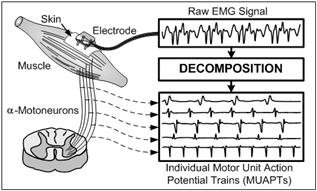

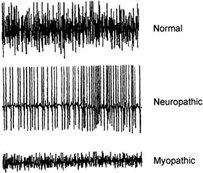
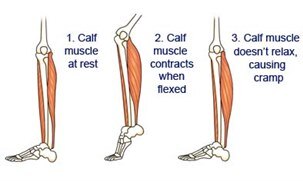
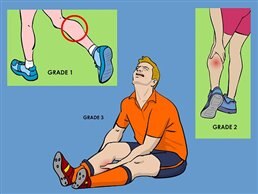
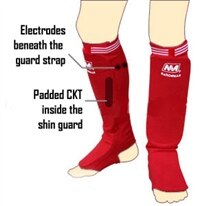
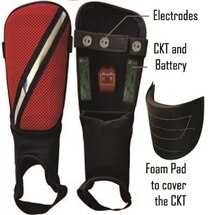
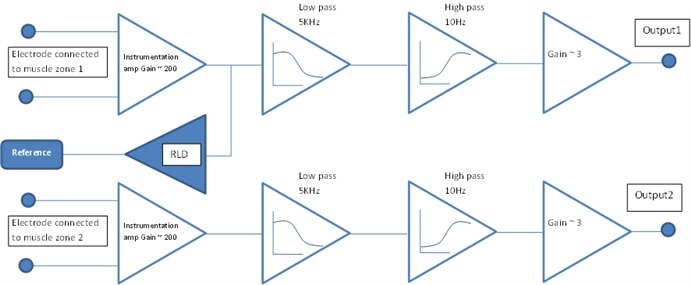
Top Comments
-

DAB
-
Cancel
-
Vote Up
+1
Vote Down
-
-
Sign in to reply
-
More
-
Cancel
Comment-

DAB
-
Cancel
-
Vote Up
+1
Vote Down
-
-
Sign in to reply
-
More
-
Cancel
Children